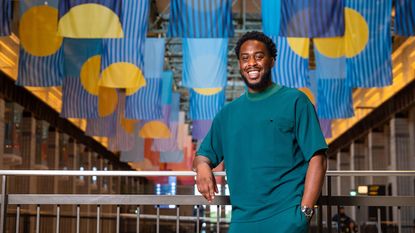‘If kids grew up going to London Design Festival they would learn so much’: architect Shawn Adams
In the first of our interviews with key figures lighting up the London Design Festival 2024, Shawn Adams, founder of POoR Collective, discusses the power of such events to encourage social change

Any round-up of emerging design talent in the past five years has, more often than not, included London-based architect Shawn Adams. And for good reason. Also an educator, writer, and social advocate, Adams and his practice POoR Collective (Power Out of Restriction) burst onto the scene in 2019 with a participatory design approach and a commitment to using architecture as a tool for social change. Born and raised in south-west London, Adams was named a RIBAJ Rising Star 2020, and last year his studio was awarded the 2023 London Design Festival’s Emerging Design Medal. We caught up with him one year on as he was busy putting together Power Shift, the second iteration of POoR Collective’s group exhibition, taking place in Brompton during London Design Festival 2024.
Shawn Adams on LDF 2024 and the life-changing power of design

Displayed inside Battersea Power Station until October 2024, ‘Together We Rise’ is a public artwork by POoR that explores the sun's movement through 100 vibrant flags suspended from the ceiling
Wallpaper*: How did architecture emerge as your calling?
Shawn Adams: There was never a particular turning point. I always said I wanted to become an architect, even before I knew what an architect really was. I don't have any architects in my family or any direct family members that pursued any jobs in the built environment, but just knowing that [as an architect] you've got the power to shape space was always so powerful to me.
W*: Do you think it's the responsibility of designers and architects to engage more with young people in schools?
SA: I think so, because state schools are really very stretched and time-poor. But from my experience, when you present something to a school, the children are super receptive to it. I think that those of us in the creative industries have to play an active role if we want more diversity. We need to be going into schools in deprived areas and showing children that architecture and design could be a potential career route.

‘Together We Rise’
W*: How can we get more kids interested in creative subjects?
SA: Firstly I think it's about showing students and their parents that there are jobs and careers that they can pursue in the creative industries. If parents don't believe there's a career to pursue, they will try and direct their kids to something else that they believe will help to create a stable future for them. There’s a perceived lack of value in creative subjects, and you see it now more than ever.
Wallpaper* Newsletter
Receive our daily digest of inspiration, escapism and design stories from around the world direct to your inbox.
W*: What do you love about working with young people?
SA: One of the main things is seeing how you impact that young person. Sometimes that impact isn't seen immediately – you might do a workshop and think they're not interested, but they will remember what you did, especially as a child, when we tend to be more impressionable. That one experience could change their whole life trajectory.

A collaboration between POoR and students from Mayesbrook Park School, Bringing Home to the Unknown is a seating sculpture that captures how young people wish to dwell, interact and play in the city
W*: Do you think the industry is changing?
SA: I definitely think the industry is trying to change, but there is still a lot of lip service. Everyone wants more diversity, especially in the creative industries, but it’s one thing to say it and another to actually get up and do something. You can say loads of great things. You can be on all the podcasts and write all the articles, and have all the right intentions. But if you're not actively doing something, then it doesn't really matter. You need to take action.
W*: What does the future hold for POoR Collective?
SA: In the next few years we want to develop a POoR community where resources and projects can be shared. We also want to build a community centre. At the moment, we've got a lot of installations and small-scale architecture, but if we could design and build a physical community centre that would be fantastic. Ultimately, we want to be a leading provider of creative opportunities for young people. That’s what we want the legacy of the business to be: an organisation that really moved the needle – that made creative industries accessible and gave young people opportunities.

POoR worked with London-based architecture practice GPAD to transform a dilapidated two-storey sports pavilion building in Copthall into a welcoming community hub that encourages people of all ages to get involved in sports
W*: You’re currently in the middle of putting together an interactive installation for this year’s London Design Festival. What do you like about the festival, and is there anything it could improve upon?
SA: I think it's great for London, as we don't have many moments where the design community comes together in the same way. I think that engagement with a younger audience is something that I would like to see more of in the future. I think [LDF] does an excellent job of engaging early career designers but when it comes to younger age groups, events where parents can bring their kids to engage with design are still missing. If there were kids who had grown up going to LDF every year, by the time they got to university or college, they would have learned so much.
-
 Discover London’s lesser-known design gems with ‘an opinionated guide’
Discover London’s lesser-known design gems with ‘an opinionated guide’‘An opinionated guide to Design London’ by Sujata Burman and Wallpaper’s Rosa Bertoli is a carefully curated tour of intriguing design spots across the capital
By Tianna Williams Published
-
 Hill House Montecito is a flowing home 'for the twenty-first century'
Hill House Montecito is a flowing home 'for the twenty-first century'Hill House Montecito by Donaldson + Partners brings together a client's vision with architectural drama and a site-specific approach for a California family home
By Ellie Stathaki Published
-
 The Brecon raises the bar for contemporary chalet chic
The Brecon raises the bar for contemporary chalet chicDesigned by Amsterdam studio Nicemakers, The Brecon sports a contemporary Swiss chalet aesthetic with midcentury echoes
By Laura May Todd Published
-
 Discover London’s lesser-known design gems with ‘an opinionated guide’
Discover London’s lesser-known design gems with ‘an opinionated guide’‘An opinionated guide to Design London’ by Sujata Burman and Wallpaper’s Rosa Bertoli is a carefully curated tour of intriguing design spots across the capital
By Tianna Williams Published
-
 22 bird houses come home to roost in ‘Dwellings’ at South London Gallery
22 bird houses come home to roost in ‘Dwellings’ at South London GalleryAs a new show opens this weekend in London, exploring the concept of the bird house, we interview one of its curators, Andu Masebo (not via Twitter)
By Hugo Macdonald Published
-
 Wallpaper's London Design Festival itinerary: don’t miss a thing
Wallpaper's London Design Festival itinerary: don’t miss a thingOur third-instalment of our four-part preview of this year's London Design Festival, from Barbie and Greater Palm Springs pavilions to the Wax Building's opening exhibition
By Tianna Williams Last updated
-
 Inside London’s new M.II store: earthy interiors offering a glimpse of ‘the darker side of Mouki Mou’
Inside London’s new M.II store: earthy interiors offering a glimpse of ‘the darker side of Mouki Mou’M.II is a new London addition to Maria Lemos’ portfolio of boutiques, with interiors by Williams Russel that feature luxurious detailing cast in a moody haze
By Tianna Williams Published
-
 Francis Sultana takes the helm at David Gill Gallery and will ‘give back to design’
Francis Sultana takes the helm at David Gill Gallery and will ‘give back to design’As David Gill becomes chairman, Francis Sultana takes over the reins as CEO of David Gill Gallery, with an ambition to support young and emerging designers
By Clare Dowdy Published
-
 First look at London Design Festival 2024, a global showcase of creative talent
First look at London Design Festival 2024, a global showcase of creative talentLondon Design Festival 2024 programme announced, with special commissions across the city's landmarks by emerging talent and forward-thinking brands (14 - 22 September 2024)
By Rosa Bertoli Last updated
-
 London Craft Week 2024: the best artisan-made works to discover across the city
London Craft Week 2024: the best artisan-made works to discover across the cityLondon Craft Week 2024 takes over the city (13-19 May 2024), we put together a list of highlights to discover the best craft across town
By Francesca Perry Published
-
 Samuel Ross announced as artistic director of London Design Biennale 2025
Samuel Ross announced as artistic director of London Design Biennale 2025London Design Biennale 2025 will mark the event’s fifth edition, under the artistic direction of Samuel Ross and with a theme of ‘Surface Reflections’
By Rosa Bertoli Published